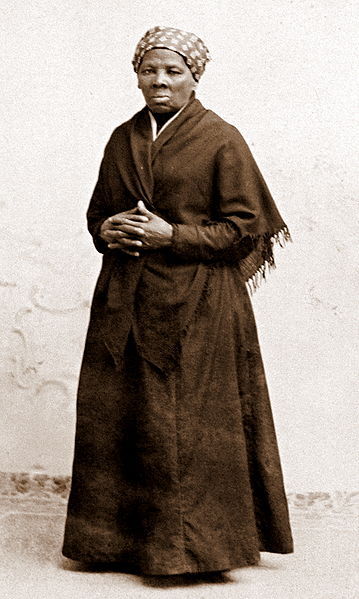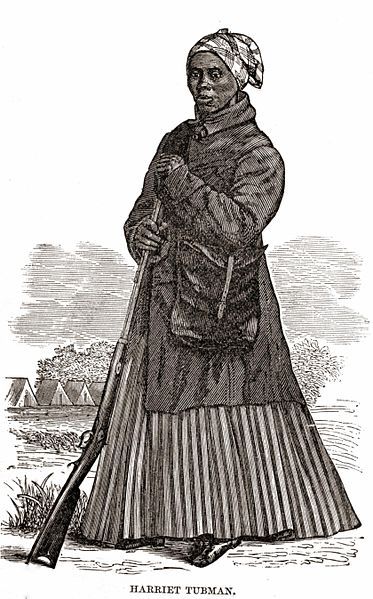Harriet Tubman the Warrior,Perhaps the most famous abolitionist of all time, history books tend to o
Harriet Tubman the Warrior,Perhaps the most famous abolitionist of all time, history books tend to only depict the elderly “Grandma Moses” Tubman of later years. What they fail to mention was that Harriet Tubman was a rough, tough badass who could tangle with the meanest of them. Born a slave in a Maryland plantation, she learned at a young age the hard knocks of life when she was struck across the head with a 2 lb lead weight by an angry slave master. For the rest of her life she suffered epilepsy, headaches, and narcolepsy. In 1849 she escaped from the plantation to relative safety in the north. After moving to Philadelphia she made it her life’s mission to rescue her family, and later others from slavery. In the 1850’s she created a vast network of escape routes throughout the south that would become a part of the Underground Railroad. She personally led 19 expeditions, rescuing around 900 runaway slaves. This was an incredibly dangerous act, as she and her fugitives could have been caught by police, slave catchers, and bounty hunters. She carried a revolver and was not afraid to use it. When one man insisted he go back to the plantation, which could compromise the entire mission, she pointed the revolver at his head and said, “You go on or die.”At the start of the American Civil War Harriet Tubman worked as a nurse and rendered assistance to freed slaves. In 1863 she became a Union scout. Due to her knowledge of the country from her time as an Underground Railroad conductor, and her skills in covert movement, Tubman was the perfect scout and spy. She led a band of scouts around the area of Port Royal Virginia, observing Confederate troop movements and conducting vital reconnaissance for the Union Army. Later that year she met another ardent abolitionist named Col. James Montgomery, commander of a brigade of Kansas infantry and African American soldiers. Montgomery was not a regular army commander, but was a skilled expert in lighting raids and guerrilla warfare. He paired up with Tubman, whose skills provided him with a great tactical advantage for his raids. He planned to launch a daring raid along the Combahee River, South Carolina, to destroy several plantations which stored foodstuffs for the Confederate Army, and to liberate the many hundreds of slaves that lived in the area. Tubman was chosen to be his personal adviser and co-commander of the expedition, and gave her the responsibility of planning and executing the raid. This made her the first woman of the Civil War, and perhaps in US military history, to lead an armed assault.On June 3rd Tubman personally led three US Navy steamboats across the Combahee River, guiding them safety through Confederate mines to the shore. With musket in hand she accompanied 300 soldiers in an assault against pickets of Confederate soldiers, who were quickly dispersed and forced into retreat. The raiders then proceeded to take as much food and supplies as could be confiscated, while burning the rest. As well hundreds of liberated slaves crowded the steamships to escape to freedom. During the evacuation the Confederates regrouped and counterattacked, but again were driven off by the raiders.The Combahee Raid was an incredible success. Thousands of dollars worth of foodstuffs, livestock, cotton, and weapons were confiscated. Several important buildings were destroyed including a rice mill, granary, and a Confederate armory. More importantly around 750 slaves were liberated, many of whom would join the Union Army.After the raid many other units would adopt similar raiding techniques, which helped break the back of the southern economy and war effort. Harriet Tubman continued her career as a scout and led numerous other raids until the end of the war in 1865. Tubman was so good at covert operations that she was never caught or observed by the enemy during the war. She never was granted a salary for her services, nor was she given a pension. After the war she tended to her family and became active in the women’s rights movement. In the 1890’s, then an elderly woman, she underwent brain surgery to treat her childhood head injury. She could not take anesthesia as the operation required her to be conscious and alert throughout procedure. As a testament to her iron will and toughness, she bit down on a bullet to manage the pain as the surgeons cut into her skull and brain. She passed away in 1911 at the age of 93. She was buried at Fort Hill Cemetery in Auburn, New York with full military honors. -- source link
Tumblr Blog : peashooter85.tumblr.com
#history#civil war#harriet tubman#abolishionists#underground railroad#badass#combahee raid#union army#scout#spies#american history#black history

